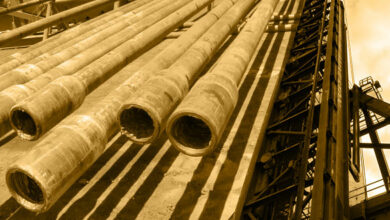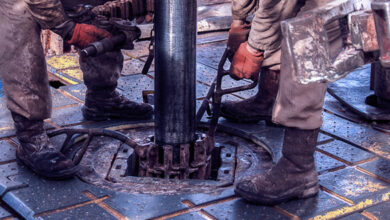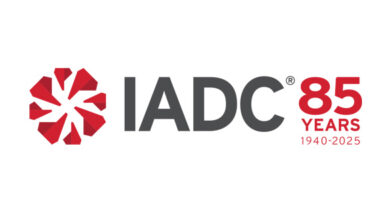Drive for efficiency must continue but comes with costs, may require industry to rethink how it drills and does business
Industry needs to find balance point where all stakeholders can achieve safe, sustainable operations, retain critical focus on people
By Linda Hsieh, Managing Editor

Niels Espeland is President, International, at Grey Wolf Drilling International, the international arm of Precision Drilling. Mr Espeland also serves as IADC Division VP International Onshore and is a member of the IADC Executive Committee.
From your perspective at Grey Wolf, what are the most critical issues that the industry is facing right now?
We have an oversupply of oil driven by efficiency gains, high oil prices for several years and increased unconventional production in North America. At the same time, we have seen stagnation in demand and growth. If you look at other commodities like steel, copper and gold, those prices have all dropped considerably, as well. They are in a similar situation that we are in today. I think one of the biggest issues for our industry today is to find the point where we can all survive and manage our business safely and efficiently, operators as well as contractors.
Recently, I was reviewing a Spears report from March 2003, when $32 a barrel was the average oil price and the price had recently risen by 24%. The lack of inventories and political tensions had led to a high-price environment. So, only 12 years ago we were operating in an environment where $32 a barrel was a high oil price. Yet, today at $40 a barrel, our industry is under severe pressure.
It really demonstrates that the cycles we’re working in today are very different than what they have been in the past. It also shows that we move between cycles and easily forget the past, perhaps a bit too fast. Just 12 years ago we were content with $32 oil. Today we are seeing a very different atmosphere, and the whole industry is pulling its oars in.

Going back to your question, I think the most critical issue is to find a stable oil price where operators can manage their exploration and development programs and contractors can continuously develop a stable business.
The second issue is about our people. Over the past 20 years, we have recognized that there is a generation change, and we have invested a lot of capital and time to train and plan for the new generation. However, right now there is a migration of people to other industries. Retaining and developing our people will be critical for long-term continuous improvement in the drilling industry.
The cost of training and development has increased considerably over the past decade due to more complex training for more complex rigs and equipment. Both drilling contractors and operators have set significantly higher standards for competency and operational excellence.
But today, in many places, there is tremendous pressure to accept dayrates at which it is challenging to sustain a proper business. It’s important for operators to know that contractors are doing their best to keep up with higher standards for equipment, process optimization and competence, and that this will have a cost at the end of the day.
As you said, just 12 years ago, $32 oil was considered high. Is it the rising cost that got us in trouble since then?

The world’s population is growing faster than ever before, and we’ve been seeing huge development out of countries like China and Russia. The financial crash in 2008 was the first indication that what was happening around us was not sustainable. Look at the growth of the oil price from 2003 to 2008 – it went from $25 a barrel to $125 a barrel, and then we saw a significant downward adjustment. It’s like an earthquake in many ways – you can only put so much stress on an economy, so much stress on the industry, so much stress on a financial institution, until you generate this sort of earthquake. I think what we’re seeing now is the afterquakes. We had a very fast recovery after 2008, and we probably should have taken more time to consider what really happened and taken a slower path in our growth strategies.
I think what we are seeing right now is another adjustment that we might have to live with for the coming years.
Once we come out of this adjustment period, how do you think the industry will be different?
Every time we come out of a downturn, we come out at a higher level, both in terms of technology and competency. Look at offshore, where a rig that was acceptable 10 years ago is not acceptable anymore in today’s market. So companies are scrapping or decommissioning older assets and preparing for better times with more modern and better equipment and better people. I believe this time we will also come out stronger also with the preparedness and competency of our personnel.
With so much emphasis being put on performance optimization, what is your take on performance-based contracts for the drilling industry?
In principle, the concept of performance-based contracts is a good idea. The only problem is where you put the baseline and at what stage. What has happened in the past is that you set a baseline when you agree on the performance drilling contract. However, as you improve, the goal post changes. Look at North American unconventional plays, where in certain areas wells have been driven down from 40 days to 15 days per well. We’ve done the same in the Middle/Far East, where we went from drilling wells in 20 days to drilling them in five days. This is all part of the drive to manage costs. We are more efficient, but our costs have also gone up. In terms of dayrates, I believe that contractors today are not being recognized for the efforts they have to put in to drill these efficient wells. All in all, I believe we are moving more toward performance-based contracts, especially in larger field developments
There has been a lot of industrialization of the well construction process in North America. Do you see a move toward this same industrialization in other regions?
I don’t think this is truly particular to North America. It’s very pronounced there because the numbers are big, but everywhere in the world drilling contractors are following the same process of continuous improvement. In the Middle East, where most of Precision’s international work takes place, industrialization of the process has been going on for years. Without it, some of these countries would not be seeing the production levels they are seeing now. For example, in the Sultanate of Oman, production was declining only a few years ago to a level where they were producing no more than 700,000 barrels a day. This past autumn, they reached a production in excess of 1 million bbl per day. They would not have reached that production level without an industrialized process. There are similar examples in other Middle East and Far East countries.
How are the challenges to continuous improvement in the Middle East different than those in North America?
In North America, everything is around you. In a matter of hours, you can have every tool, equipment or service you need. When you are in remote places like South Iraq, Kurdistan, Northern Pakistan, some places in India and North Africa, it is very different. Import or customs issues and even visa issues for people can affect how efficient you are. There are a lot of variables that affect the way wells are drilled, not because a tool or technology is not available but because it’s difficult to get it to the wellsite when you need it.
Do you see a trend toward increasing automation for onshore rigs working outside North America? What do you see in the future for drilling automation?
For the past 20 years, there has been a continuous process to automate rigs. It’s a natural progression, and one day we will probably have rigs drilling without people. In a lot of industries, automation has already come into play. A train goes by my office every two minutes, and there’s no driver, but it stops every time at the same location. It reduces its speed, it stops, and it opens the doors to let passengers get on and off. We have autodrillers and many other tools on our rigs today that are used to varying degrees. It’s just a matter of adjusting the automation to fit the environment and type of well.
I do think automation in terms of well control might be the right direction. If you look at the catastrophic events in our industry, the root cause usually goes back to people not following procedures or a lack of communication. It would be great if we could take that element away. Obviously it adds a cost, but if you look at industrialized renewable energy products and installations, it is all automated. Our industry will have to follow.
As you mentioned, there’s a lot of pressure right now on drilling contractors in terms of operator demand for cost reductions and performance expectations. What operational challenges do these pressures bring?
It’s critical that we retain our standards and retain an effective supply chain. This means getting everything you need to the rig when you need it. In this environment, you cannot keep as much spares as you need on the rig, so you are really dependent on having a timely and effective supply chain. This is not just about the vendors. It’s about how you manage the whole process.
We talk about reduced costs all the time, but we really should be talking more about cost optimization. That’s what we do everyday. We manage the process of an operation, but we also manage our cost.
Besides cutting dayrates, what are other ways to achieve cost reductions to make more projects economically viable at $40 oil?
A dayrate cut is the easiest way for an operator to cut costs. However, a cut of 10% in a rig’s dayrate represents less than 1% saving on a well. We have spent the last three decades trying to optimize all aspects of the drilling process. I think the industry should look at itself and ask whether we are drilling too many wells. At what commodity price can we achieve a sustainable business? What can we cut? We need to continue the technology drive, we need to continue the efficiency drive, we need to continue improving our processes, and we need to continue enhancing safety. So I ask, what is the cost of the continuous drive for improvement?
If the cost of that is not compatible with $40 or $50 oil, we have to rethink the way we drill wells and the way we run our business. I think this will require close working relationships between contractors and operators on everything from best practices to equipment selection to process improvements. We really need to make sure that the way an operator thinks is more compatible with the way a contractor thinks, and vice versa. That’s the only way we can find other ways of cost reduction.
The rig market is significantly oversupplied right now. Do you think we’ll start to see some of the newer, advanced-technology rigs built for shale drilling start to move to other parts of the world? For Precision, what are the key considerations when facing the decision of whether to scrap a rig?
The high oil price from 2010 to 2014 created an oversupply of rigs in North America, and I think it will stay that way for some time. In the Middle East, there are few stacked rigs. The oversupply of rigs has not happened in the same way here because there was not a large-scale boom development or increase in oil production; it has been steady growth. You ask if we’re going to see North American rigs move to other parts of the world, and I would say probably not to the extent that you might think. The rig requirements or specifications in North America are very different from requirements in countries like Saudi Arabia or Oman – I am not talking about the basic rig itself but the equipment around it, like the mud systems, BOPs camps and auxiliary equipment. I believe moving the North American rigs will require large capital investments, so I do not foresee that a significant number of land rigs will be moved to the international arena.
I do foresee that a lot of lower-tier rigs will be decommissioned. In the future, we will drill more wells with fewer rigs. That means only the fit-for-purpose rigs with the latest technologies will be out there.
For Precision Drilling, when we look at where we want to be, we don’t look at where we want to be tomorrow. We work on a five- to 10-year horizon. Our motto is High Performance, High Value. That means modern rigs, highly competent crews and advanced processes and standards. Our decisions to decommission rigs are made as part of a long-term modernization and improvement plan.
Further, what is a tier 1 rig today will not be a tier 1 rig 20 years from now, so you need to stay on top of technology and processes, and you need to have a long-term plan for that.
What changes in either the industry’s business model or methods for collaboration do you think might result from the lower oil price environment?
Collaboration is, and will continue to be, essential for survival. Without collaboration at all levels, the industry will struggle, and we will not achieve operational excellence. This is not just between contractor and operator – it can also be between operator and operator. For example, I think rig-sharing agreements between operators could lead to a more efficient utilization of equipment and personnel. DC




